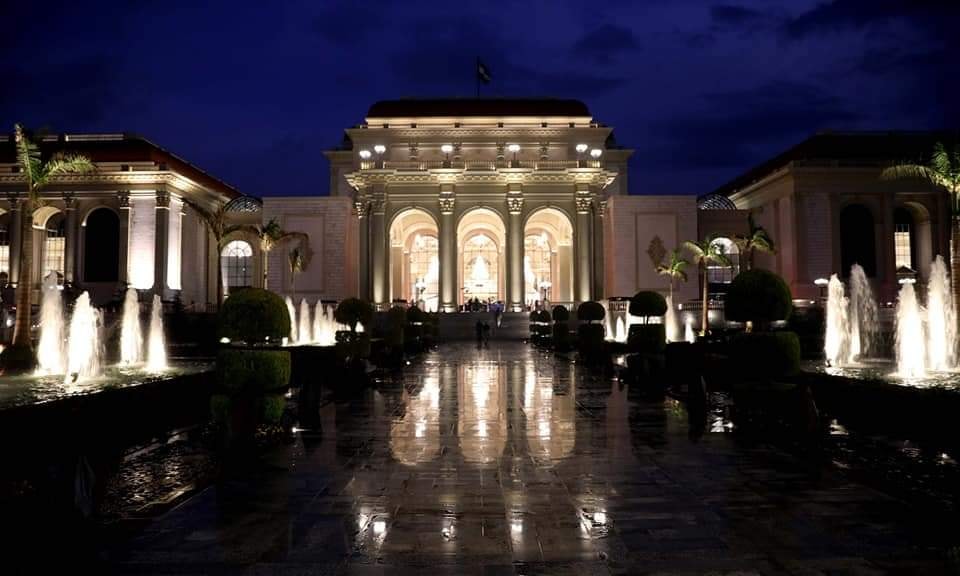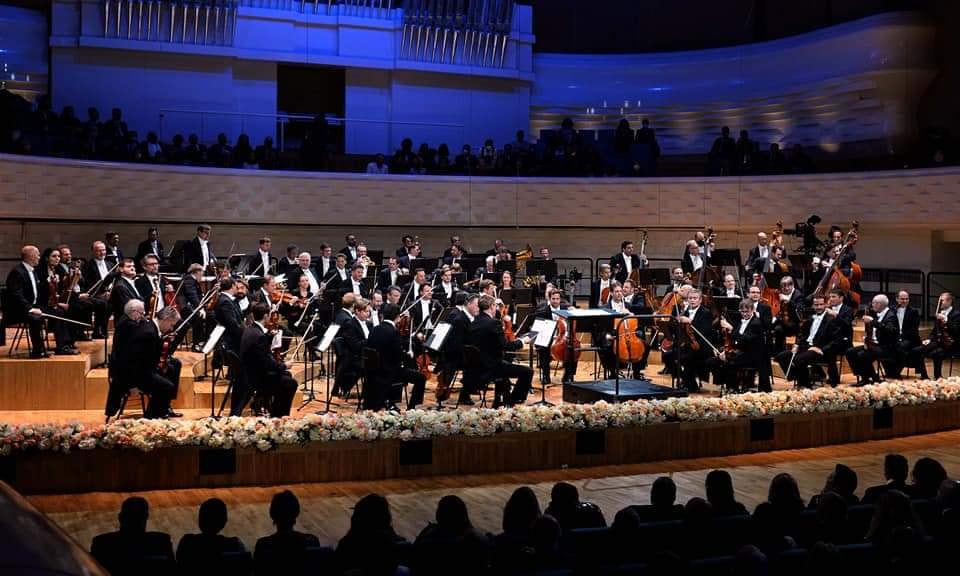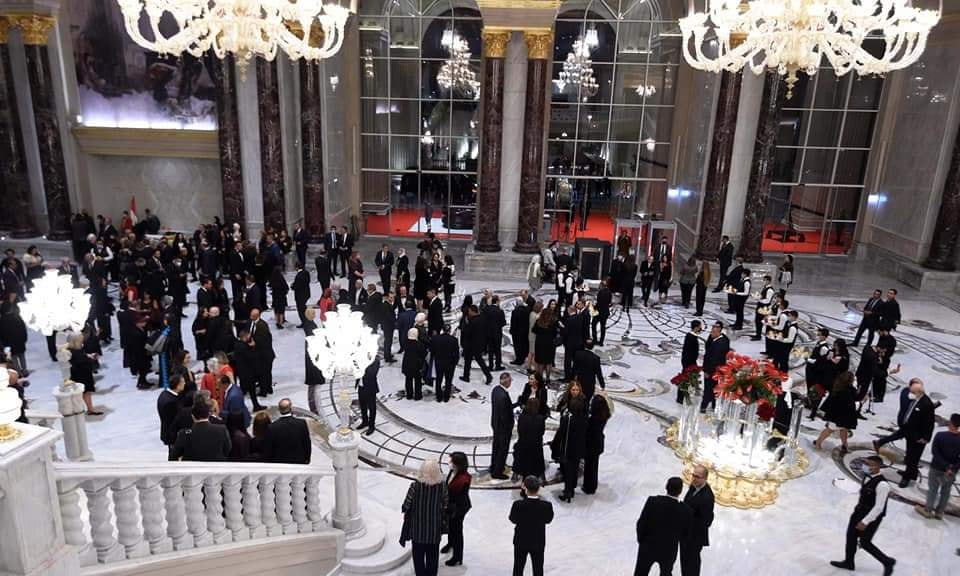The names Vienna Philharmonic Orchestra and Riccardo Muti need no introduction. Anyone interested in classical music is aware of their stellar status. While the Vienna Philharmonic performs dozens of concerts a year and tours extensively, their highlight – known to listeners worldwide – is the New Year concert broadcast to millions of viewers annually. The famed Italian conductor Riccardo Muti’s collaboration with the Vienna Philharmonic spans five decades. Since the 1990s, he has conducted the Vienna’s New Year concerts on six occasions, most recently in December 2020.
Attending an evening like this is a unique treat every music lover must dream of experiencing at least once in their lifetime. The orchestra’s Cairo sojourn on its way home from a Far East tour across cities in Korea, Japan, and China included two performances for the opening of the 1200-seat concert hall at the New Opera House in Cairo’s New Administrative Capital. The opera is the biggest such facility in the Middle East, built according to Egypt Vision 2030 as part of the City of Arts and Culture, the large complex that comprises numerous other stages, a contemporary art museum, a movie theatre and a huge library, among other cultural spaces.



The Thursday 20 November entry-by-invitation concert featured Mozart’s Symphony no. 35 in D Major, K.385, ‘Haffner’ and Franz Schubert’s Symphony no. 8 in C Major, D944, ‘The Great’, while the 21 November concert, to which tickets could be bought, featured Schubert’s Symphony no. 4 in C minor, D417, ‘The Tragic’, Stravinsky’s Divertimento, Suite from Ballet ‘Le Baiser de la Fee’ and Mendelssohn-Bartholdy Symphony no. 4 in A major, Op. 90, ‘Italian’.
Heavy rain and strong wind filling the road to the New Capital with dusty fog and mud did not discourage the music lovers, who were welcomed by a red carpet at the new cultural eden. An hour of chitchat among the audience, many of whom hailed from Egypt’s musical community, was followed by the much anticipated concert. On their recent Far East tour, the orchestra was described by critics as “nothing short of greatness” and “exciting and flawless.” Critical reviews of the Vienna Philharmonic as well as Muti’s work with symphonic, operatic and contemporary music ensembles have used such superlatives for decades.
Undeniably one of the pillars of the orchestra’s unique sound and quality is its illustrious history dating back to 1842, and its faithfulness to a rich tradition of classical music. Together with long periods of strong management and conductors who add their share of knowledge – Hans Richter, Karl Böhm, Herbert von Karajan and of course Muti, among many others – this gives the orchestra its power. Research has repeatedly shown that culture is transmitted through generations which, as they come and go, shape ways of thinking, processing and accordingly impact the final cultural product. Austria’s astounding classical music history and this orchestra’s 180 year lifespan guarantee unchanging quality in ever-changing social, political, economic and cultural landscapes, placing it at the very top.
At the same time, the reputation of a conductor such as Riccardo Muti is more than justified. Muti began his musical career at the age of seven, and he was to retain fond memories of his parents, as can be seen in an interview he gave the Italian newspaper La Repubblica: “[My mother Gilda was] shaped by the Neapolitan culture that comes from Frederick II, the German emperor, but also from Naples and Puglia [in southeast Italy]. She was beautiful, slender and elegant, with wavy hair. A line of blue blood ran in her family. Of my parents, the great music lover was my father, Domenico, with a beautiful tenor voice. He deemed it necessary for us to have a musical education.” The talented young man thus ended up studying with composer Bruno Bettinelli, conductor Antonino Votto and Nino Rota.

In 1967, when he was only 26 years old, Muti was awarded first place by the jury of the Guido Cantelli competition for conductors in Milan. This was followed by a decades-long career, during which he has accumulated dozens of awards and honours, and conducted the most prestigious orchestras, from the Berlin Philharmonic to the Teatro alla Scala in Milan, and from the Bavarian Radio Symphony Orchestra to the New York Philharmonic and the Orchestre National de France. Currently, Muti is in charge of two renowned orchestras: the Chicago Symphony Orchestra and the Orchestra Giovanile Luigi Cherubini. Those musical achievements are not just bullet points in a conductor’s CV; they are the essence of a man whose musical development we can hear in every note of the orchestra he conducts.
When listening to Mozart’s Symphony no. 35, which was written in 1782, at the height of the composer’s career in Vienna, we are taken on an almost cinematic adventure, an emotional charge that is partially motored by the piece’s original function: at the core of the composition is a serenade (commissioned for the ennoblement of Sigmund Haffner) which Mozart later reworked into a Haffner Symphony. On 20 November, the string-dominated tuttis made their way to the listeners’ ears with their texture showcasing the brilliantly homogeneous delivery. As if working with paints, the strings’ one strong colour filled the hall’s breathtaking architecture with the gleam of sound, and thus testifying to the perfection and minute precision of the musicians acting as one solid body.
And, speaking of strings, one cannot but admire the same perfection showcased in Schubert’s gigantic Symphony no. 8, where especially in the 2nd movement, the pizzicato pulsed delicately through the low strings in their immaculate uniformity, all set against the brass and woodwind lining. That latter section is characterised by a highly conversational character, and it showcased singing-like qualities, a delight to contemplate and cheer along.
No matter which composition or section of the orchestra, the Vienna Philharmonic’s cultural history is obvious in every aspect of their delivery, from balanced definition to layered of accents and powerful climaxes. While the regular listeners enjoy the music and understandably take its complexity for granted, an attentive and experienced listener will know that this seemingly easy presentation is in fact only possible with a world-class orchestras’ highest skills.

No need to mention that behind the output of any concert stands a conductor. On 20 and 21 November, Riccardo Muti was the indisputable master of the evening. Without resorting to showy gestures, in his work Muti projects a unique confidence as he shapes the compositions and infuses the score with life. With minimal direction, he is in full control, gently guiding the orchestra on their journey. At times the Naples-born artist seems to succumb to the pleasure of the music, placing his trust entirely in musicians who already speak his language. At other times, the 80-year-old will make a surprise move, something he provides only in very controlled doses – just enough to create a sparkle of energy that will suffuse the musicians’ path through our ears. The many encounters between the Vienna Philharmonic and Muti, as well as their recent Far East tour have definitely helped to create the unique musical image the audience was offered, but it is skill over the ensemble’s malleability that allows the conductor to enact his vision at each performance, bringing us the experience of perfection and joy.
As the concert ended on Saturday 20 November, the audience would not let the orchestra and Muti leave the stage. The never-ending applause of the listeners was rewarded with an encore in the form of the famed Kaiser walzer (Emperor Waltz), an Austrian specialty. Many praise the Vienna Philharmonic for performing their native Johann Strauss II repertoire in an unrepeatable way – hence the popularity of the New Year concerts. It is the magic of the orchestra's accents and breaths, rises and falls, their inimitable embroidery of climaxes, their delicacy and airy delivery that makes those waltzes stand out.
That wonderful experience was repeated on 21 November, with a different programme and an equally enthusiastic reception. Sunday evening also witnessed a stupendous ovation and another encore, this time the Overture to Verdi’s La forza del destino, a work that benefits from a specific specialisation of Muti’s, since he is renowned for conducting Giuseppe Verdi.
*****

With such a remarkable opening of the new concert hall, the audience is eager to find out about the future of the opera and the City of Arts and Culture. Some of the plans for the opera and the city have already been revealed by its artistic advisor, musician and arts manager Ahmed Abouzahra – the man behind inviting Vienna Philharmonic and Riccardo Muti to Egypt.
“This was a very important step in positioning the opera and the whole complex on the cultural map,” Abouzahra told Al Ahram Weekly. “When you start with such big international names, many doors open for the benefit of our audiences and cultural life. I consider it a crucial push to set a high standard for our reputation.”
It is worth adding that the concerts were not the only attraction. Abouzahra also organised five workshops welcoming 50 young musicians, be they students of the Cairo Conservatory or Cairo Symphony Orchestra players. The musicians benefited from two violin workshops, one cello, one oboe and one French horn workshop, all led by the Vienna Philharmonic members. While participants definitely benefitted from those workshops, Abouzahra reveals that they also represented a new and important experience for the Vienna players who were acquainted with Egyptian musicians and culture at large.
It goes without saying that Abouzahra’s passion, hard work and many years of networking are bound to enrich the space with countless international gems. Prior to the Vienna Philharmonic, which opened the concert hall, a few other events had opened other stages at the edifice, such as three concerts that took place in the Drama Hall.
“The complex is rich in cultural buildings. It includes a conservatory, a ballet academy and the oud house, among other important cultural and educational institutions. Their opening is linked to the whole development of the complex and that of the New Administrative Capital,” Abouzahra clarifies, stressing that these facilities will all be of the highest quality imaginable. “We already have 76 grand pianos that will serve the needs of the concerts and other performances, conservatory, theatres, dressing and rehearsal rooms, practice studios, etc.. The opera also holds a large number of strings, percussion and other instruments purchased from world renowned manufacturers. We imported seats and music stands of the best quality from France...”
While the opera and its complex develop at a fast pace, the audience is awaits the opening of the new opera’s biggest gem, which is its state-of-the-art grand hall. With a capacity of 3500 seats and groundbreaking technical solutions, it will stage grand productions embedded in its components. At this point, Abouzahra cannot provide exact dates for the grand hall opening or the opening of other facilities at the City of Arts and Culture, and the programming of events has yet to be announced.
“But what I can say for sure is that the audience will be able to enjoy many very high quality concerts and performances, whether they come from the international scene or the Arab world.”

*A version of this article appears in print in the 25 November, 2021 edition of Al-Ahram Weekly.
Short link: